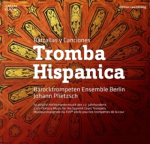Tromba Hispanica
Battallas y Canciones
17th-Century Music for the Spanish Court Trumpeters
At the beginning of the 16th century a mighty axis was formed in Europe: the Spanish royal house joined with the Habsburg Empire, to which belonged also the nothern parts of Italy. These ties were a reason for numerous travels undertaken by envoys, diplomats and also rulers, who usually – as an important element of representation – were accompanied by ensembles of trumpeters. A huge ensemble of the Viennese court ca 1600 consisted of 30 trumpet and timpani players.
Its Spanish counterparts were two slightly smaller ensembles: first, established before joining Isabela and Ferdinand courts, and the other one: a newly-founded ensemble of the Italian trumpet players.
German trumpeters were also playing an important role in this “concert of nations” demonstrating might and splendor. Thanks to a perfect guild organization and good education they enjoyed a high renown and high “market position”. When in 1638 two German players were employed at the Spanish court – in order to be able to pay them, their patrons had to dismiss two Italian and six Spanish players.
While the Italian trumpet music has been in major part researched and catalogued, numerous treasures of Spanish music still await discovery. for example, in the organ music from 17th century Spain we can find often the titles such as Battalla, Cancion de Clarines, Trompetas y Clarines etc. Sometimes it may indicate the use of clarín register, which means characteristic horizontal pipes called “Spanish trumpets”, but cannot be excluded that it refers to the transciption of popular pieces for the trumpet or trumpet ensemble, whose dirct recording in writing was forbidden by the rules of the guild of trumpeters.
Also the participation of percussion almost never has been transmitted in the music notation. However, thanks to the accounts from the period, we know about the practice of using a variety of percussion instruments. Besides timpani and drums traditionally accompanying the trumpets, we shall hear a colourful richness of small rim drums, frame drums, tabourines and bells emphaizing Mediterranean-dance charakter of this programme.
Besides the Italian trumpet music written for the Habsburg court, pieces written by the Spanish Composers, preserved in the organ tabulatures will be presented. These are reconstuctions, giving an interesting insight in the highly-developed trumpet art of the Iberian Penisula.
Johann Plietzsch 2012
